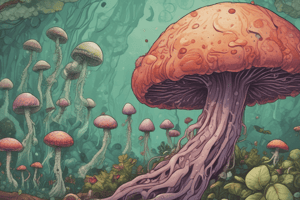Podcast
Questions and Answers
Which of the following azoles have a similar spectrum to other azoles?
Which of the following azoles have a similar spectrum to other azoles?
- Itraconazole and Micafungin
- Voriconazole and Posaconazole (correct)
- Itraconazole and Voriconazole
- Posaconazole and Caspofungin
What is the mechanism of action of Echinocandins?
What is the mechanism of action of Echinocandins?
- Inhibition of C Mannan binding
- Inhibition of Chitin Synthase
- Noncompetitive inhibition of β-1,3-D-glucan synthase enzyme (correct)
- Competitive inhibition of β-1,3-D-glucan synthase enzyme
Which of the following Echinocandins is not fungicidal against Aspergilli?
Which of the following Echinocandins is not fungicidal against Aspergilli?
- Caspofungin
- Micafungin
- Anidulafungin
- None of the above (correct)
What is the effect of inhibiting β-1,3 glucan synthase on fungal cells?
What is the effect of inhibiting β-1,3 glucan synthase on fungal cells?
Which of the following is not a target of antifungal drugs?
Which of the following is not a target of antifungal drugs?
What is the effect of losing chitin in fungal cells?
What is the effect of losing chitin in fungal cells?
Which of the following Echinocandins is under investigation?
Which of the following Echinocandins is under investigation?
What is the role of C-mannan in fungal cells?
What is the role of C-mannan in fungal cells?
Which of the following is a nucleoside peptide antifungal?
Which of the following is a nucleoside peptide antifungal?
What is the origin of Echinocandins?
What is the origin of Echinocandins?
Study Notes
Fungal Infections
- Coccidioidomycosis is caused by Cocidioides immitis and is geographically confined to the Americas.
- Histoplasmosis is caused by Histoplasma capsulatum.
- Brazilian blastomycosis is caused by Paracoccidioides brasiliensis.
- Blastomycosis is caused by Blastomyces dermatitidis.
Opportunistic Infections
- Opportunistic infections cause life-threatening infections in immunocompromised subjects, such as HIV patients, those with blood diseases, cancers, and diabetics.
- Candidiasis, thrush, and vulvo-vaginitis are caused by Candida albicans.
- Cryptococcal meningitis is caused by Cryptococus neoformans.
- Aspergillosis is caused by Aspergillus sp.
- Mucormycosis is caused by Murcor sp.
- Pneumocystis carinii pneumonia is caused by Pneumocystis carinii.
Targets of Antifungal Agents
- Fungal cells are complex and similar to eukaryotic cells, sharing similarities with other eukaryotes.
- The cell wall has unique organelles that fulfill the criteria for selective toxicity and differs greatly from bacterial cell walls, not affected by cell wall inhibitors like β-lactams and Vancomycin.
- Three main mechanisms of antifungal agents exist: inhibition of cell wall formation, cell membrane disruption, and inhibition of cell division.
Inhibition of Cell Wall Formation
- Interference with fungal cell wall biosynthesis has not been as successful and effective as penicillin and cephalosporins against bacteria.
- Many chemicals have been discovered that interfere with various steps in fungal cell wall synthesis with excellent antifungal activity in vitro.
- Development of these agents into useful drugs has proven very difficult.
Cell Membrane Disruption
- Antifungal agents that disrupt the cell membrane do so by targeting ergosterol, either by binding to the sterol, forming pores and causing the membrane to become leaky, or inhibiting ergosterol biosynthesis.
- Ergosterol is like mammalian cholesterol, thus agents binding ergosterol may have a cytotoxic effect in the host tissue.
Inhibition of Cell Division
- Targeting the microtubule effects in forming the mitotic spindle.
- Inhibiting DNA transcription.
Amphotericin B
- Must be reserved only for severe infections due to non-selective action on cholesterol in mammalian cell membranes, leading to toxicities.
- Side effects include headache, fever, chills, anorexia, vomiting, muscle and joint pain, and severe renal toxicities linked to interaction with cholesterol.
Nystatin
- Nystatin was originally isolated from Streptomyces noursei in 1951 and was the first polyene to be used.
- Binds to ergosterol in fungal membrane, causing membrane to become leaky.
- Available in oral tablets, powder for suspension, vaginal tablets, pastilles, for local therapy only (not absorbed).
Polyenes - Natamycin
- Natamycin was first isolated from cultures of Streptomyces natalensis.
- Structures consist of a 26-membered lactone instead of the 38 for Nystatin and Amphotericin B.
- Like other polyene antifungal agents, it binds to ergosterol in fungal membrane, causing membrane to become leaky.
- Effective against Tinea pedis (athlete's foot).
Azole Derivatives
- Chemical pentacyclic structure with 2 nitrogen atoms.
- Water insoluble except fluconazole.
- Preferentially inhibit cytochrome P450 enzymes and are fungistatic.
- Modify cytochrome P450 enzyme.
Ketoconazole
- Orally well-absorbed imidazole of the second generation.
- Ketoconazole is the only imidazole for systemic use.
- CSF penetration is very weak.
- Hepatotoxicity restricts its use.
- Also interacts with other molecules.
Third Generation
- They are mostly triazoles, containing three nitrogen atoms in a ring.
- Fluconazole, Itraconazole, Voriconazole, Posaconazole, and Revuconazole.
- Voriconazole and Posaconazole have a similar spectrum as other azoles.
- Itraconazole is used to treat bronchopulmonary aspergillosis.
- Adverse effects include gastrointestinal, hypersensitivity, and hepatotoxicity.
Echinocandins
- They are semisynthetic, synthesized from Glarea lozyensis.
- Noncompetitively inhibit β-1,3-D-glucan synthase enzyme.
- Caspofungin, Micafungin, and Anidulafungin.
- Fungicidal against Aspergilli, Candida, and P.carinii.
- No cross-resistance amongst strains resistant to Amphotericin B or Azoles/Triazole.
- No activity against Cryptococcus neoformans, Fusarium, and Rhizopus.
- Effective against Pneumocystis carinii.
Cell Wall Synthesis Inhibitors - Under Development
- β-1,3 glucan synthetase inhibitors: Papulacandins – glycolipid antifungal produced by Papularia sp.
- Chitin Synthase inhibitors: Polyoxins and Nikkomycins – nucleoside peptides.
- C Mannan binding antifungals: Pradimicins and Benanomicins.
Studying That Suits You
Use AI to generate personalized quizzes and flashcards to suit your learning preferences.
Related Documents
Description
Quiz about different types of fungal infections, including Coccidioidomycosis, Histoplasmosis, and Blastomycosis, as well as opportunistic infections in immunocompromised individuals.




